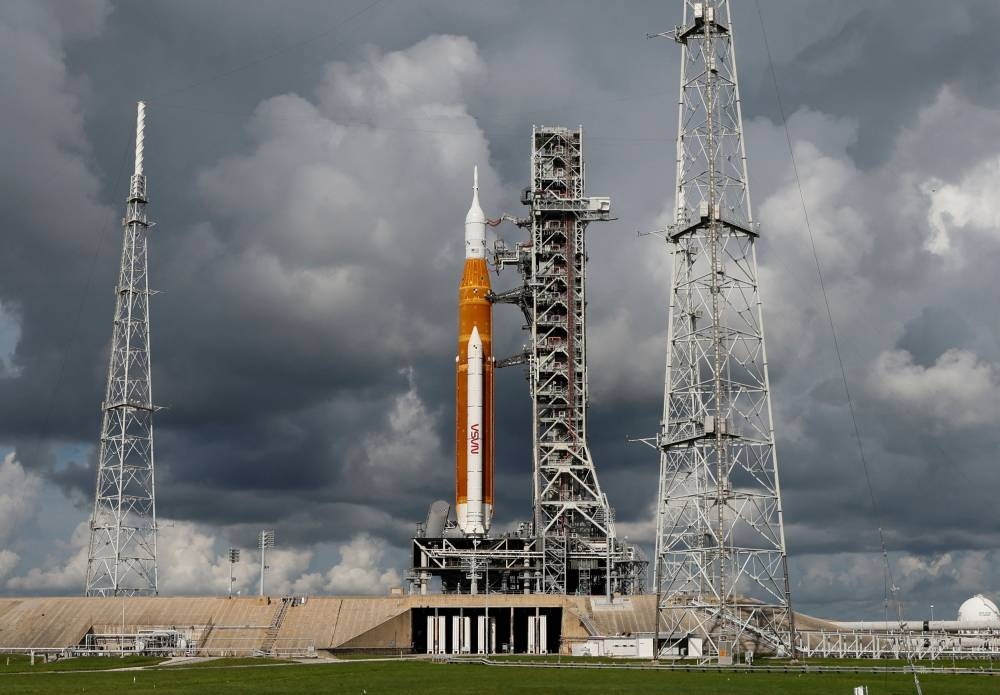CAPE CANAVERAL, Florida, Sept 3 — Ground teams at the Kennedy Space Center on Saturday began fuelling NASA’s giant, next-generation rocketship for its debut launch on an uncrewed test flight to the moon, five days after an initial lift-off attempt was thwarted by technical problems.
The 32-story tall Space Launch System (SLS) rocket and its Orion capsule were due for blast-off from Cape Canaveral, Florida, at 2:17 p.m. EDT (1817 GMT), kicking off the US space agency’s ambitious moon-to-Mars Artemis program 50 years after the last Apollo lunar mission.
The previous launch bid on Monday was halted by engineering snags. NASA says technicians have since remedied the issues.
Weather is an additional factor beyond NASA’s control. The latest forecast saw a 70 per cent chance of favourable conditions during Saturday’s two-hour window, according to the US Space Force at Cape Canaveral.
Before dawn, launch teams started the lengthy, delicate process of filling the rocket’s core-stage fuel tanks with several hundred thousand gallons of super-cooled liquid oxygen and liquid hydrogen propellant.
Engineers stopped loading liquid hydrogen around 7:30 a.m., roughly an hour into the complex process, to fix a leak.
If the countdown were halted again, NASA could reschedule another launch attempt for Monday or Tuesday.
Dubbed Artemis I, the mission marks the first flight for both the SLS rocket and the Orion capsule, built under NASA contracts with Boeing Co and Lockheed Martin Corp, respectively.
It also signals a major change in direction for NASA’s post-Apollo human spaceflight program, after decades focused on low-Earth orbit with space shuttles and the International Space Station.
Named for the goddess who was Apollo’s twin sister in ancient Greek mythology, Artemis aims to return astronauts to the moon’s surface as early as 2025, though many experts believe that time frame will likely slip.
Twelve astronauts walked on the moon during six Apollo missions from 1969 to 1972, the only spaceflights yet to place humans on the lunar surface. But Apollo, born of the US-Soviet space race during the Cold War, was less science-driven than Artemis.
The new moon program has enlisted commercial partners such as SpaceX and the space agencies of Europe, Canada and Japan to eventually establish a long-term lunar base of operations as a stepping stone to even more ambitious human voyages to Mars.

Spaceflight Stress Test
Getting the SLS-Orion spacecraft off the ground is a key first step. Its first voyage is intended to put the 5.75-million-pound vehicle through its paces in a rigorous test flight pushing its design limits and aiming to prove the spacecraft suitable to fly astronauts.
If the mission succeeds, a crewed Artemis II flight around the moon and back could come as early as 2024, to be followed within a few more years with the program’s first lunar landing of astronauts, one of them a woman, with Artemis III.
Billed as the most powerful, complex rocket in the world, the SLS represents the biggest new vertical launch system NASA has built since the Saturn V of the Apollo era.
Barring last-minute difficulties, Saturday’s countdown should end with the rocket’s four main RS-25 engines and its twin solid-rocket boosters igniting to produce 8.8 million pounds of thrust, about 15 per cent more than Saturn V, sending the spacecraft streaking skyward.
About 90 minutes after launch, the rocket’s upper stage will thrust Orion out of Earth orbit on course for a 37-day flight that brings it to within 60 miles of the lunar surface before sailing 64,374 km beyond the moon and back to Earth. The capsule is expected to splash down in the Pacific on October 11.
Although no humans are aboard, Orion will be carrying a simulated crew of three - one male and two female mannequins — fitted with sensors to measure radiation and other stresses that real-life astronauts would experience.
The spacecraft also is set to release a payload of 10 miniaturized science satellites, called CubeSats, including one designed to map the abundance of ice deposits on the moon’s south pole.
A top objective for the mission is to test the durability of Orion’s heat shield during re-entry as it hits Earth’s atmosphere at 24,500 mph (39,429 kph), or 32 times the speed of sound, on its return from lunar orbit - much faster than more common re-entries of capsules returning from Earth orbit.
The heat shield is designed to withstand re-entry friction expected to raise temperatures outside the capsule to nearly 2,760 Celsius.
More than a decade in development with years of delays and budget overruns, the SLS-Orion spacecraft has so far cost NASA least US$37 billion (RM165.7 billion). NASA’s Office of Inspector General has projected total Artemis costs will run to US$93 billion by 2025.
NASA defends the program as a boon to space exploration generating tens of thousands of jobs and billions of dollars in commerce. — Reuters






















